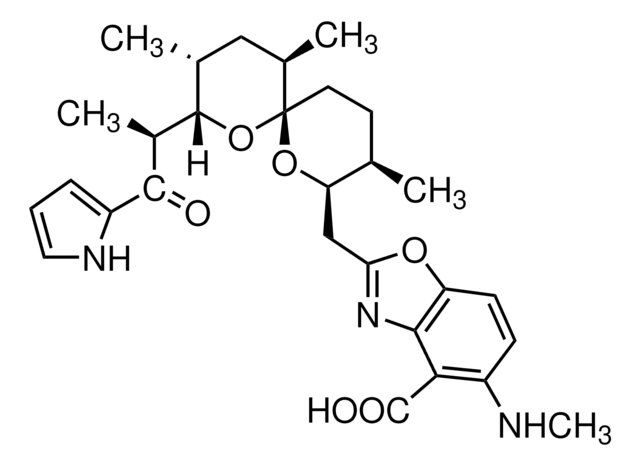616394
TPEN
Synonyme(s) :
TPEN, N,N,Nʹ,Nʹ- tetrakis-(2-Pyridylmethyl)ethylenediamine
About This Item
Produits recommandés
Pureté
≥97% (titration)
Niveau de qualité
Forme
solid
Pertinence de la réaction
reagent type: chelator
Fabricant/nom de marque
Calbiochem®
Conditions de stockage
OK to freeze
Couleur
tan
Solubilité
ethanol: 10 mg/mL
0.1 M phosphate pH 7.0: 25 μM
DMSO: soluble
Conditions d'expédition
ambient
Température de stockage
15-25°C
InChI
1S/C26H28N6/c1-5-13-27-23(9-1)19-31(20-24-10-2-6-14-28-24)17-18-32(21-25-11-3-7-15-29-25)22-26-12-4-8-16-30-26/h1-16H,17-22H2
Clé InChI
CVRXLMUYFMERMJ-UHFFFAOYSA-N
Description générale
Application
- Poly(ADP-ribosyl)ation of p53 contributes to TPEN-induced neuronal apoptosis.: This study investigates the role of poly(ADP-ribosyl)ation of the tumor suppressor protein p53 in neuronal apoptosis induced by TPEN, highlighting mechanisms of cell death in neurodegenerative diseases (Kim HL et al., 2015).
- Essential role of p53 in TPEN-induced neuronal apoptosis.: This article explores the critical involvement of the p53 protein in apoptosis initiated by TPEN in neuronal cells, offering insights into potential therapeutic targets for neuroprotection (Ra H et al., 2009).
- Clioquinol induces autophagy in cultured astrocytes and neurons by acting as a zinc ionophore.: Demonstrates how Clioquinol, similar to TPEN, functions as a zinc ionophore to induce autophagy, particularly in neurological contexts, which may be relevant for understanding TPEN′s mechanisms (Park MH et al., 2011).
Avertissement
Reconstitution
Autres remarques
Cherny, R.A., et al. 1999. J. Biol. Chem. 274, 23223.
Aballay, A., et al. 1995. Biochem. J.312, 919.
Jiang, S., et al. 1995. Lab. Invest.73, 111.
Sheridan, R.E. and Deshpande, S.S. 1995. Toxicon33, 539.
McCabe, M.J., et al. 1993. Lab. Invest. 69, 101.
Hinkle, P.M., et al. 1992. J. Biol. Chem.267, 25553.
Baba, A., et al. 1991. Brain Res. 557, 103.
Forbes, I.J., et al. 1991. Exp. Cell Res. 195, 224.
Csermely, P. and Somogyi, J. 1989. J. Cellular Physiol.138, 593.
Raspe, E., et al. 1989. Eur. J. Pharmacol.163, 345.
Arslan, L.P., et al. 1985. J. Biol. Chem.260, 2719.
Informations légales
Code de la classe de stockage
11 - Combustible Solids
Classe de danger pour l'eau (WGK)
WGK 3
Point d'éclair (°F)
Not applicable
Point d'éclair (°C)
Not applicable
Certificats d'analyse (COA)
Recherchez un Certificats d'analyse (COA) en saisissant le numéro de lot du produit. Les numéros de lot figurent sur l'étiquette du produit après les mots "Lot" ou "Batch".
Déjà en possession de ce produit ?
Retrouvez la documentation relative aux produits que vous avez récemment achetés dans la Bibliothèque de documents.
Les clients ont également consulté
Notre équipe de scientifiques dispose d'une expérience dans tous les secteurs de la recherche, notamment en sciences de la vie, science des matériaux, synthèse chimique, chromatographie, analyse et dans de nombreux autres domaines..
Contacter notre Service technique










